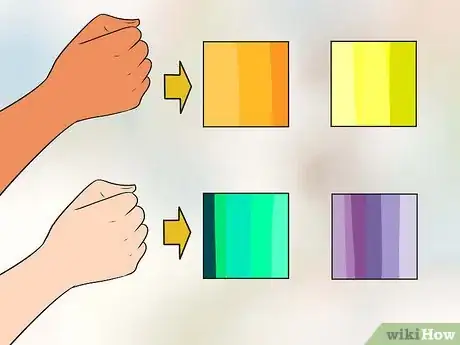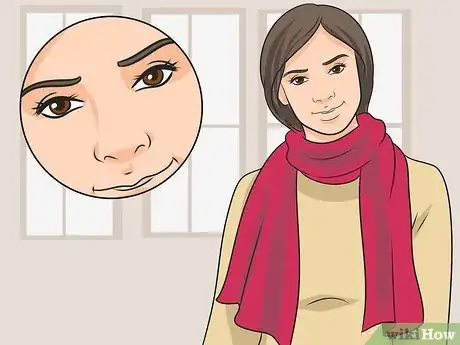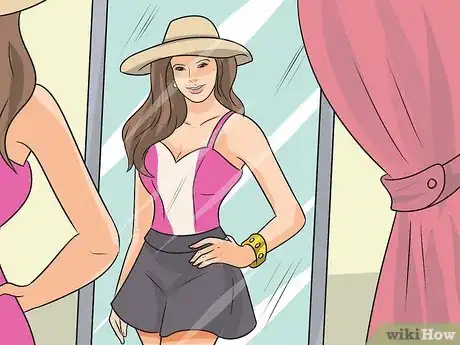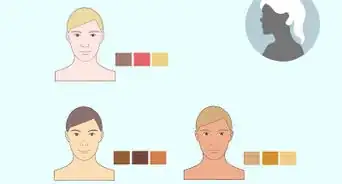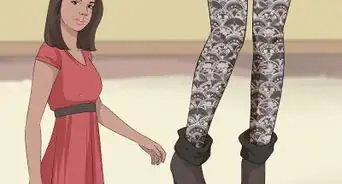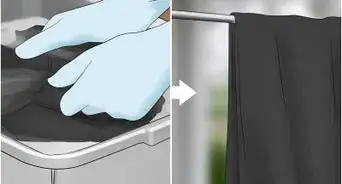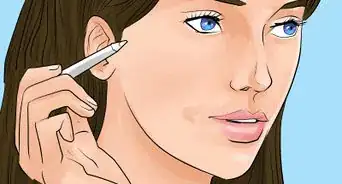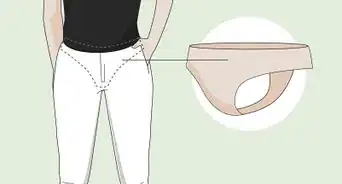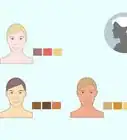This article was co-authored by Kathi Burns, CPO®. Kathi Burns is a board certified Professional Organizer (CPO) and Founder of Organized and Energized!, her consulting business with a mission to empower people to master their environment and personal image by assisting them in taking control, making change and organizing their lives. Kathi has over 17 years of organizing experience and her work has been featured on Better Homes and Gardens, NBC News, Good Morning America, and Entrepreneur. She has a BS in Communication from Ohio University.
There are 12 references cited in this article, which can be found at the bottom of the page.
This article has been viewed 603,729 times.
If you struggle to make your favorite colors look good on you, you might be missing out on a key bit of styling know-how. We’re talking about color analysis! Color analysis matches clothing colors to your skin tone to make sure your wardrobe and your body work together to show off your best hues. We’ll show you how to find your dominant undertones, determine your go-to neutrals, and then mix and match your outfits to your personal color profile so you can strut your technicolor stuff.
Things You Should Know
- Examine the veins in your wrist to find your undertones. Cool undertones wear cool colors, warm wears warm colors, and neutral can wear anything.
- Find your best neutral colors by holding neutral clothes up to your face in a mirror and deciding which looks best.
- Put together outfits that use your best neutrals as a base, and colors that match your undertones on top.
Steps
Analyzing Your Skin Tone
-
1Determine your skin's undertone with the vein or white shirt test. Some colors may look better on you depending on the undertone of your skin.[1] Your undertone is the dominant hue of your skin—warm, cool, or neutral. Warm undertones tend to look best in warm colors, cool in cool colors, and neutral in any color. Use one of the following tests to determine your skin’s undertone:
- Vein test: Look at the veins on your wrist or palm. If your veins appear green, you have warm undertones. Blue or purple means you have cool undertones. And if you have a mix or you can’t tell, you have neutral undertones.
- White shirt test: Pull out a white shirt (or any white fabric) and hold it up to your face in a mirror lit by natural light. If your face appears rosy, you have cool undertones. If it appears more yellow, you’re warm. Can’t decide? Neutral.[2]
-
2Narrow your colors down according to your skin brightness. In addition to your undertones, your primary skin shade can help you narrow down your best colors.[3] Generally, colors that create a contrast in brightness with your skin are more flattering. For example, bright colors tend to wash out light skin, while dark colors might not pop on darker skin.[4]
- If your skin is dark, saturated oranges and yellows almost always look great, even if your undertone is cool.
- Greens and blues tend to pop on people with fair skin.[5]
- Bold "jewel tones" like emerald, ruby, and amethyst flatter paler skin regardless of undertone.
Advertisement -
3Use your hair color as a hint about your undertones and best shades. Your hair color, like your skin undertones, can also inform your wardrobe colors. People with light blonde hair typically have cool skin undertones, and so look great in cool-toned clothing. Yellow blondes, on the other hand, mesh better with warmer hues.[6]
- Black, dark brown, or true red hair often indicates cool undertones.
- Brassy reds or lighter browns often indicate warm undertones.
- If you dye your hair, pick dye colors that match your undertones to better complement your skin.
-
4Sort your closet into a “color season” that matches your undertone. Many stylists narrow the color profiles down into “seasons” to help their clients stick to a preselected palette.[7] Typically, “fall” and “spring” colors go well with warm undertones, while “winter” and “summer” colors go well with cool undertones. Now that you know your undertones, pick out clothing that coincides with a matching season of your choice. Some colors in each season are:
- Spring: Warm, pastel colors like soft yellows, pinks, or oranges.
- Summer: Sharper cool colors like sea blue, deep purples, and strong reds.
- Fall: Warm earth tones like burnt oranges, browns, and darker greens.
- Winter: Dark or bright colors with cool undertones, like royal blue, emerald green, or hot pink.
Picking Your Neutrals
-
1Grab 6 objects, each a different neutral color. Neutral colors are those with low or no color saturation, like whites, blacks, grays, and browns.[8] In this example, the 6 neutrals are light and dark gray, light and dark brown, navy, and black. Grays and browns come in warm and cool variations, so pick ones that match your color profile.
- Make sure the object is almost entirely monochromatic to more easily analyze its color.
-
2Hold the object up to your face in a mirror and examine the undertones. Find an area with plenty of natural light to do this, and decide which color makes you look your best.[9] Even neutral colors have undertones that can match your skin. Examine the objects’ undertones. For example, is it a warm gray, or a cooler, bluer gray? Does the object’s undertones match your skin's undertones?
- This is largely subjective and open to your taste, so don’t stress too much about it!
- Your best neutral is often close to your natural hair color.
-
3Choose 1 or 2 neutrals to build your wardrobe around. Pick a couple objects that match your undertones the most closely, and get other neutral clothes that closely match those colors. These colors will make up the workhorses of your wardrobe, and will constitute the majority of your pants, dresses, jackets and shoes.[10]
- Of course, you’ll incorporate plenty of other colors, but your neutrals make for a reliable, flexible base to build on.
- Avoid mixing neutrals in an outfit to keep your look cohesive.
Coordinating Your Wardrobe
-
1Assemble some go-to pieces that complement your undertone. Pick either a color season or a few of your favorite shades of a single color that matches your undertones, and make this your go-to palette.[11] It’s best to stick to 2-3 colors to stay cohesive; a good outfit is usually made up of 1 neutral and 1 main color with an optional small amount of accent color. More colors tend to make an outfit look busy.
- Of course, don’t toss your favorite clothes just because they don’t match your color—if it looks good on you, it looks good on you!
-
2Wear tops and scarves that bring out the color in your eyes. If you want to make your eyes "pop," make sure the clothes on your torso complement them. Pick either a color that matches your eyes closely or one that’s on the opposite side of the color wheel. For our brown-eyed fashionistas, go for blues, lavenders, or reds.[12]
- Similarly, match your lipstick to your undertones to help unify the upper portion of your body.
-
3Pick a few accessories in a complementary accent color. Wearing complementary colors—or colors that sit on polar ends of the color wheel—is a quick way to make any outfit stand out.[13] Have a look at a color wheel, and choose 2 colors that sit on opposite sides to build a complementary color scheme. Then, choose 1 color to make up the dominant color of your outfit, and accessorize with the other color.
- For example, an orange tie or pocket square can make you stand out in an otherwise conservative navy suit. Likewise, an aqua belt on a salmon dress can be an unusual but stylish choice.
- Use this technique sparingly, as too many competing colors can begin to clash.
-
4Stick to one type of metal for accents and jewelry. Even though they make up a small part of your outfit, shiny metals tend to attract the eye and stand out against your outfit. Using 2 different colors of metal can clash or look busy, so stick to 1 if you’re unsure. Silver and platinum are cool-toned metals, while gold and bronze are warm-toned.[14]
-
5Wear colors that express your personality. People tend to associate certain colors with certain vibes or attitudes.[15] For example, earth tones and light, unsaturated warm colors can make you look friendly and approachable. Bright reds are attention grabbers. Dark, monochromatic colors can make you look stern or powerful. Wear muted or pale colors if you want to be noticed less. Bright, bold colors, especially purple, may make you seem more creative.
- Your favorite or go-to colors might not match your undertones, and that’s okay! Comfort and confidence is often more important than precise color-matching.
- In addition, you may find that your favorite color has hues that do match your undertone. For example, reds come in both cool and warm tones, and both make a bold outfit.
-
6Try on an outfit before wearing it out of the house. Getting your wardrobe just right is a trial-and-error process. Crafting the perfect closet takes time and a willingness to experiment.[16] Practice putting outfits together at home and analyzing your work in the mirror. Or, send a pic of the outfit to a friend for some handy input.
- Always remember that if you like how you feel in an outfit, then it’s a good outfit! Taste is subjective, but good vibes are priceless.
Expert Q&A
Did you know you can get expert answers for this article?
Unlock expert answers by supporting wikiHow
-
QuestionHow do you know what colors look best on you?
 Kathi Burns, CPO®Kathi Burns is a board certified Professional Organizer (CPO) and Founder of Organized and Energized!, her consulting business with a mission to empower people to master their environment and personal image by assisting them in taking control, making change and organizing their lives. Kathi has over 17 years of organizing experience and her work has been featured on Better Homes and Gardens, NBC News, Good Morning America, and Entrepreneur. She has a BS in Communication from Ohio University.
Kathi Burns, CPO®Kathi Burns is a board certified Professional Organizer (CPO) and Founder of Organized and Energized!, her consulting business with a mission to empower people to master their environment and personal image by assisting them in taking control, making change and organizing their lives. Kathi has over 17 years of organizing experience and her work has been featured on Better Homes and Gardens, NBC News, Good Morning America, and Entrepreneur. She has a BS in Communication from Ohio University.
Image Consultant
References
- ↑ Kathi Burns, CPO®. Board Certified Professional Organizer. Expert Interview. 31 December 2019.
- ↑ https://www.cosmopolitan.com/style-beauty/beauty/advice/a5119/find-your-undertone/
- ↑ Kathi Burns, CPO®. Board Certified Professional Organizer. Expert Interview. 31 December 2019.
- ↑ https://www.womanandhome.com/fashion/colour-analysis-what-colour-suits-me-207107/
- ↑ https://www.thecoolist.com/pick-suit-colors/
- ↑ https://www.thelist.com/21212/choose-perfect-hair-color-skin-tone/
- ↑ Kathi Burns, CPO®. Board Certified Professional Organizer. Expert Interview. 31 December 2019.
- ↑ https://www.eviemagazine.com/post/what-colors-look-best-on-you-based-on-your-skin-tone
- ↑ https://www.eviemagazine.com/post/what-colors-look-best-on-you-based-on-your-skin-tone
- ↑ Kathi Burns, CPO®. Board Certified Professional Organizer. Expert Interview. 31 December 2019.
- ↑ Kathi Burns, CPO®. Board Certified Professional Organizer. Expert Interview. 31 December 2019.
- ↑ https://www.glamour.com/story/do-you-ever-wear-clothes-in-ce
- ↑ https://www.collegefashion.net/fashion-tips/a-foolproof-guide-to-matching-colors-in-your-outfits/
- ↑ https://fashionweekonline.com/the-golden-rules-to-matching-jewelry-to-your-skin-tone
- ↑ https://www.color-meanings.com/clothing-colors-what-your-clothes-say-about-your-personality/
- ↑ https://www.insider.com/how-to-figure-out-your-season-color-analysis-worth-it-2022#after-our-meeting-dina-sent-me-an-autumn-color-fan-where-she-marked-colors-i-would-look-best-in-19
About This Article
To choose your best clothing colors, start by looking at the veins on your wrist to see if they appear green, which means your skin has a warm undertone. In that case, pick clothes in warm colors, like reds, oranges, or yellows, to complement your skin’s undertone. Alternatively, for veins that have a blue or purple tint, which indicates a cool skin undertone, choose clothes in cool colors, such as greens, blues, or purples. You can also get a flattering look by picking clothes in colors that contrast in brightness with your skin, like a ruby shirt against light or pale skin. To learn how to pick your best neutrals, keep reading!


